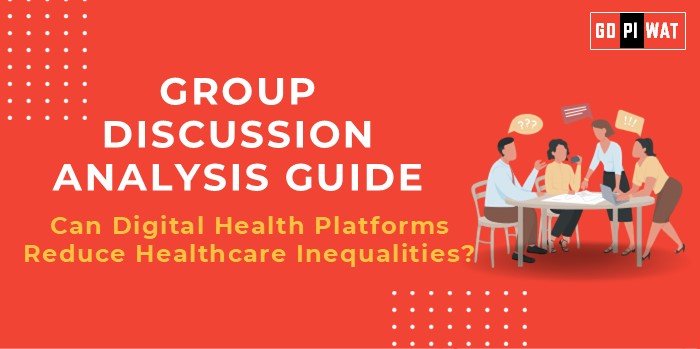📋 Group Discussion Analysis Guide: Can Digital Health Platforms Reduce Healthcare Inequalities?
🌐 Introduction to Digital Health Platforms and Healthcare Inequalities
Context Setting: Digital health platforms are revolutionizing healthcare by offering remote consultations, e-prescriptions, and health monitoring. These technologies hold immense potential to bridge the healthcare gap between urban and rural populations globally.
Topic Background: With over 6 billion smartphone users worldwide, the advent of digital health platforms has brought new hope for equitable healthcare delivery. However, disparities in technology adoption, infrastructure, and digital literacy pose challenges to achieving their full potential.
📊 Quick Facts and Key Statistics
- 🌍 Global Digital Health Market Value: $350 billion (2024), projected to grow at a CAGR of 17%.
- 🌐 Internet Users Worldwide: 5.4 billion (2024), highlighting global connectivity but with urban-rural gaps.
- 🇮🇳 India’s Rural Healthcare Deficit: 75% of doctors cater to urban areas, leaving rural regions underserved.
- 📱 Digital Health Platform Reach: Over 200 million Indians accessed telemedicine during the COVID-19 pandemic.
👥 Stakeholders and Their Roles
- 🏛️ Governments: Policy formulation, subsidies for telemedicine, and rural internet access.
- 💼 Private Companies: Investment in health tech innovations and expanding affordable solutions.
- 🩺 Healthcare Professionals: Leveraging technology to reach underserved areas.
- 👥 Citizens: Adopting digital platforms for health services and raising awareness.
- 🌍 NGOs and International Agencies: Advocacy and funding for inclusive health initiatives.
🏆 Achievements and Challenges
Achievements:
- ✨ Increased Access: Platforms like Practo and Arogya Setu bridged urban-rural gaps during the pandemic.
- 💰 Cost Efficiency: Reduced the cost of consultations and diagnostic processes.
- 🔍 Preventive Care: AI-driven platforms enable early diagnosis and monitoring.
- 📡 Scalability: Expanded to remote areas with mobile connectivity.
Challenges:
- 📉 Digital Divide: Only 20% rural households in India have reliable internet access.
- 🔒 Data Privacy Concerns: Limited cybersecurity frameworks compromise patient confidentiality.
- 📚 Technological Illiteracy: Low digital literacy limits effective usage.
🌏 Global Comparisons:
- 🇪🇪 Estonia: Leading in e-health records and accessibility.
- 🇷🇼 Rwanda: Leveraging drones for rural medical deliveries.
📖 Case Study:
India: E-Sanjeevani OPD provided 100 million teleconsultations in 2023, but rural participation remained under 30%.
📚 Structured Arguments for Discussion
- ✅ Supporting Stance: “Digital health platforms democratize healthcare by reducing geographical and financial barriers.”
- ❌ Opposing Stance: “Technological adoption alone cannot solve deep-seated healthcare inequalities.”
- ⚖️ Balanced Perspective: “While digital health platforms offer innovative solutions, their success hinges on addressing the digital divide and ensuring inclusivity.”
🎯 Effective Discussion Approaches
- 💡 Opening Approaches:
- Statistical Impact: “With 200 million Indians using telemedicine in 2021, digital health platforms are reshaping healthcare delivery.”
- Contrast: “While digital tools proliferate in cities, rural access remains an uphill battle.”
- Case Study: “E-Sanjeevani OPD showcases the dual promise and challenge of telemedicine in India.”
- 🛠️ Counter-Argument Handling:
- Highlight infrastructure limitations but propose mobile data subsidies.
- Address privacy concerns with global GDPR-like regulations.
🔍 Strategic Analysis of Strengths and Weaknesses
Strengths:
- 📈 Scalability
- 💸 Cost-efficiency
- 🔍 Preventive care
Weaknesses:
- 📉 Digital illiteracy
- 📶 Poor rural internet infrastructure
Opportunities:
- 🤖 AI advancements
- 📡 5G expansion
- 🤝 Public-private partnerships
Threats:
- 🔒 Data breaches
- 📉 Uneven adoption
🎓 Connecting with B-School Applications
- 🌟 Real-World Applications: Linking health equity to leadership in operations and healthcare management.
- ❓ Sample Interview Questions:
- “How can telemedicine be scaled to underserved areas?”
- “What role do public-private partnerships play in health tech adoption?”
- 📘 Insights for Students:
- Explore health-tech business models.
- Analyze cybersecurity and rural outreach strategies.


